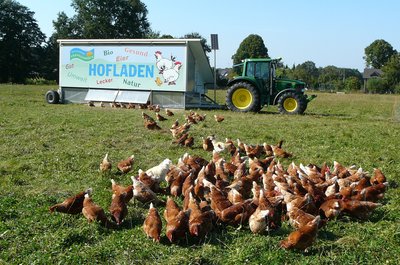Siemens control system provides comfort to free-range hens
Wednesday, 18 September, 2013
A Siemens control system is providing free-range hens with more comfort and also reducing their risk of infection. The system automatically controls the daily routine - eg, feeding, lighting changes and chicken release onto pastures - in transportable chicken coops. These coops are driven to new locations every week, which lowers the risk of infection for the animals.
The ‘chicken mobiles’, built by Stallbau Iris Weiland, can house between 200 and 1200 chickens. The energy needed to operate the trailers’ equipment is generated by roof-mounted solar panels fitted with rechargeable gel batteries.

The mobile henhouses solve a common problem with free-range poultry: chickens like to peck around in groups, but if they stay too long in one place, germs can form in the waste they leave in the soil. This is why they need to be frequently relocated to new pastures, which ensures the chickens remain healthy even without antibiotics - and such healthy hens can lay more than 90 eggs on average over 100 days.
The henhouses are hooked up to a tractor every week and moved to a new site, along with all the chickens. After a few weeks, the former location has completely regenerated and can be used again.
Stallbau Iris Weiland wanted a henhouse control system that would be easy to program and which would automatically adjust daily operations in line with different seasons and locations. Siemens Industry Automation met these requirements with its Logo! control system.
Designed for simple automation tasks, Logo! is equipped with a variety of integrated features that are logically linked via a graphic user interface. The product is used in heating and building systems, motor control units, solar power facilities and on ships, as well as other applications. The system’s ‘astronomical clock’ function, which stores data on daylight and night-time periods for every day of the year and for every location, is particularly useful for the henhouses.
The control system is responsible for the automated charging of the gel batteries with energy from the solar panels. It also simplifies software updates. In all henhouse models, the system helps to open the flaps in the morning to let the chickens out and close them again at night. It also turns the LED lights on and off, and opens and closes the nests. The larger henhouse models are equipped with conveyor belts that automatically transport feed and manure. New programs can be sent by email - all farmers have to do is copy the program onto an SD memory card that they then insert into the control device.
The 180 automated henhouses that have hit the road to date have performed so well that a new version for breeding chickens was recently presented.
Fluoride boosts water-processed perovskite solar cells
Queensland University of Technology has developed a water processing method to fabricate more...
Multibuild solar installation delivered at City of Playford
Trinasolar partnered with Venergy Solar to deliver a multibuild solar installation across the...
Oracle assists major distributor in clean energy transition
Essential Energy, an electricity distributor in Australia, is said to have modernised its...










